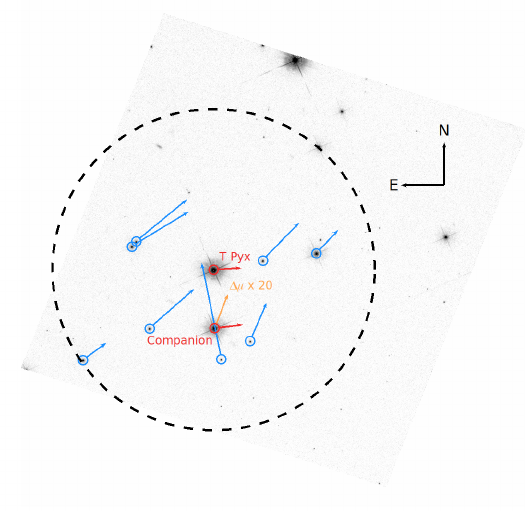Title: A Triple Star Origin For T Pyx and Other Short-Period Recurrent Novae
Authors: C. Knigge, S. Toonen, T.C.N. Boekholt
First Author’s Institution: Department of Physics and Astronomy, University of Southampton, Southampton, UK
Status: accepted for publication at MNRAS

Image Credit: NASA
In physics, and especially in astrophysics, we have long since learned a particular fact: to every well established phenomenon (even those that we believe to have understood quite well) there are some outliers, some systems, some occurrences in nature, which appear to contradict or at least challenge our understanding of this process or event.
Today’s paper talks about a strange stellar system, called T Pyx. What makes T Pyx so special are its frequent eruptions, which appear to defy most of what we know about binary systems.
White Dwarfs in Multiple Star Systems
T Pyx consists of at least a white dwarf (WD) and a so-called ‘donor object’. This makes it at least a binary system, and we know it is an interacting one, at that. In an interacting binary system, one or both component stars have filled or exceeded its Roche limit. This means, material from one star (the donor star) flows across and onto the companion (the accretor).
One form of binary system is one in which one of the stars has already left the main sequence and turned into a white dwarf, while the other component has not yet shed its outer layers and turned into a stellar corpse. If this system is interacting, the WD accretes mass from its donor star. This accretion rate is mostly too low for the WD to achieve steady hydrogen burning. Once the pressure in the layer of accrete material, which is not degenerate, reaches critical pressure, these WDs are then expected to display recurrent explosive hydrogen burning (i.e. novae eruptions). For most cases, the time span between two eruptions is expected to be larger than 10 000 years, since this value depends on the mass of the WD and the rate at which it accretes.
For very massive white dwarfs with rapid accretion rates (e.g. due to very massive donor stars), the time span between two eruptions can sink to less than 100 years. However, in this regime, the white dwarf accretes more mass between two explosive hydrogen burnings than is ejected during the eruption, and it thus grows in mass. Therefore, these white dwarfs may reach the Chandrasekhar limit and are then candidates to undergo type Ia supernovae.
For such large accretion rates, long orbital periods are implied, since they stem from either a massive or a companion star, evolved beyond the main sequence, which makes for wide binary systems.
Thus, as the authors of today’s paper note, most known systems with recurrent novae eruptions have orbital periods longer than 12 hours.
A Curious System
Enter T Pyx. The donor star in this system is a very low mass star – perhaps even a substellar object – of less than 10% the Sun’s mass. Yet the white dwarf in T Pyx erupts roughly every 30 years, even though its orbital period is merely 1.8 hours. We know that these eruptions are actually explosive hydrogen burnings and that T Pyx has an extraordinarily high accretion rate. How can this be possible at an orbital period this short? Calculating the expected mass transfer for this system, it results in a value around 1000 times too low for such frequent eruptions.
There is another…
The authors of today’s paper consider a new possible explanation: a more distant tertiary companion to the system. The gravitational influence of such a third object is known to have dramatic consequences on the evolution of a close binary system. Thus naturally, the first step in pursuing this approach is to try and see if T Pyx might actually be a triple system.
Lo and behold, using GAIA data, the authors revealed a very high confidence, common proper motion companion (see Fig. 1). It appears to be at a distance to the inner binary system of T Pyx of around half a lightyear and its proper motion is the only one in the neighborhood compatible with that of T Pyx. The parallaxes of the two objects are almost identical according to the GAIA catalog. Thus, the distances from the Earth to the inner binary and this candidate tertiary companion of T Pyx are almost identical within their respective errors, at around 2.9 kpc.
Photometric measurements indicate the third object has a radius of 2.25 solar radii, and placement on a color-magnitude diagram suggests it is a 1.5 solar mass sub-giant star, just leaving the main sequence and heading towards the red giant branch. Since the sub-giant phase is relatively short lived, the age of this star and therefore the entire system can be estimated to be around 2.2 billion years.

Source: Figure 1 in today’s paper
Having made a convincing case for a distant tertiary companion of T Pyx and having nailed down the properties of said companion, the authors of today’s paper turned to the question whether such a third object would be able to explain the curious properties of the system: primarily the abnormally high accretion rate of its white dwarf.
A triple system with a close inner binary, in which two stars orbit each other fairly closely and a third star orbits the binary at a larger distance, are called hierarchical triples.
Three Body Dynamics
The authors show that the nature of T Pyx as a triple system may produce an eccentric inner orbit of the white dwarf and its donor star. As opposed to isolated binary stars, for which their orbit cirulizes quickly; in three body systems, due to the corresponding dynamics, the eccentricity of the orbit may be subject to constant change or even increase. Thus, the mass transfer for these close binaries in a triple system is highly dependent on the orbital phase and may evolve rapidly. This can actually explain a mass transfer as high as we see for T Pyx. Depending on the severity of the eccentricity, the gas from the donor star may be stripped during or close to periastron and accreted onto the white dwarf; or the two stellar objects may even collide, leading to significant stellar disruptions.
It appears the mystery of the frequently erupting T Pyx system has been solved at least to a reasonable degree of certainty. Interestingly, there is a twin system, known as IM Nor, which displays similar abnormal characteristics. The authors speculate that IM Nor might in fact be actually a hierarchical triplet, too. Unfortunately, the parallax for this system in the GAIA catalog is not statistically meaningful, as it has a very high margin of error. The authors remain hopeful that this may yet change with further data releases.
Stellar systems can be wild. Just imagine for a moment the sheer forces at play in multiple star systems, how the orbits and stages of stellar evolutions of the individual stars influence each other, causing fascinating observational properties. T Pyx is one of many interesting and “abnormal” systems, while many more sit out there, waiting to have their secrets revealed.
Astrobite edited by Aldo Panfichi
Image Credits: NASA, today’s paper




